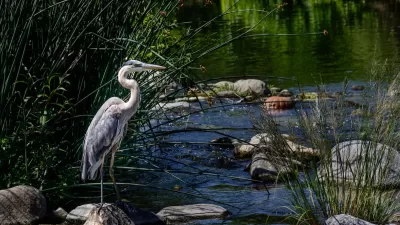From its mountain tributaries, to the San Fernando Valley, through Downtown, and across the basin into the Pacific Ocean, Christian MilNeil tells the story behind the ecological and recreation rehabilitation of the Los Angeles River.
Unarguably one of the region's most photographed and filmed landmarks, the Los Angeles River's miles of concrete-lined channels have appeared in numerous films, advertisements, and music videos. Now advocates are hoping to rehabilitate the river's post-apocalyptic appearance by tying in aspects of ecology and livability.
Christian MilNeil, writing for Grist, takes the reader on a four-part tour of the river, from its start in the mountains above the San Fernando Valley to its mouth in Long Beach. Perhaps most interesting are his comments regarding how residents and visitors to the city interact with their river, from the sprawling and busy Sepulveda Dam Recreation Area, where the unpaved river returns to its wild roots for a short stretch, to the lifeless Confluence Park in the Glassel Park neighborhood, near the tangle of highway interchange viaducts that fly over the historic confluence of the L.A. River and the Arroyo Seco.
Then there's the famed stretch just east of Downtown Los Angeles, with its art deco bridges, power lines, railroads, and near-complete isolation from the rest of the city. Here, many of the most interesting and largest plans to rehab the river are taking place. Plans include "re-wilding" the river with an unpaved bottom and lining its banks with parks and redevelopment. And though "[a]ll this sounds pretty good to sustainability advocates - and to a growing number of political leaders..., until Los Angeles embraces those broader changes...restoration efforts like the one at Tujunga Wash [in the San Fernando Valley] will end up spending more tax money...to achieve less."
Read more about the Los Angeles River in MilNeil's four-part series in Part 1, Part 2, Part 3, and Part 4.
FULL STORY: Los Angeles River checks into rehab

Planetizen Federal Action Tracker
A weekly monitor of how Trump’s orders and actions are impacting planners and planning in America.

Restaurant Patios Were a Pandemic Win — Why Were They so Hard to Keep?
Social distancing requirements and changes in travel patterns prompted cities to pilot new uses for street and sidewalk space. Then it got complicated.

Map: Where Senate Republicans Want to Sell Your Public Lands
For public land advocates, the Senate Republicans’ proposal to sell millions of acres of public land in the West is “the biggest fight of their careers.”

Maui's Vacation Rental Debate Turns Ugly
Verbal attacks, misinformation campaigns and fistfights plague a high-stakes debate to convert thousands of vacation rentals into long-term housing.

San Francisco Suspends Traffic Calming Amidst Record Deaths
Citing “a challenging fiscal landscape,” the city will cease the program on the heels of 42 traffic deaths, including 24 pedestrians.

California Homeless Arrests, Citations Spike After Ruling
An investigation reveals that anti-homeless actions increased up to 500% after Grants Pass v. Johnson — even in cities claiming no policy change.
Urban Design for Planners 1: Software Tools
This six-course series explores essential urban design concepts using open source software and equips planners with the tools they need to participate fully in the urban design process.
Planning for Universal Design
Learn the tools for implementing Universal Design in planning regulations.
Heyer Gruel & Associates PA
JM Goldson LLC
Custer County Colorado
City of Camden Redevelopment Agency
City of Astoria
Transportation Research & Education Center (TREC) at Portland State University
Camden Redevelopment Agency
City of Claremont
Municipality of Princeton (NJ)




























